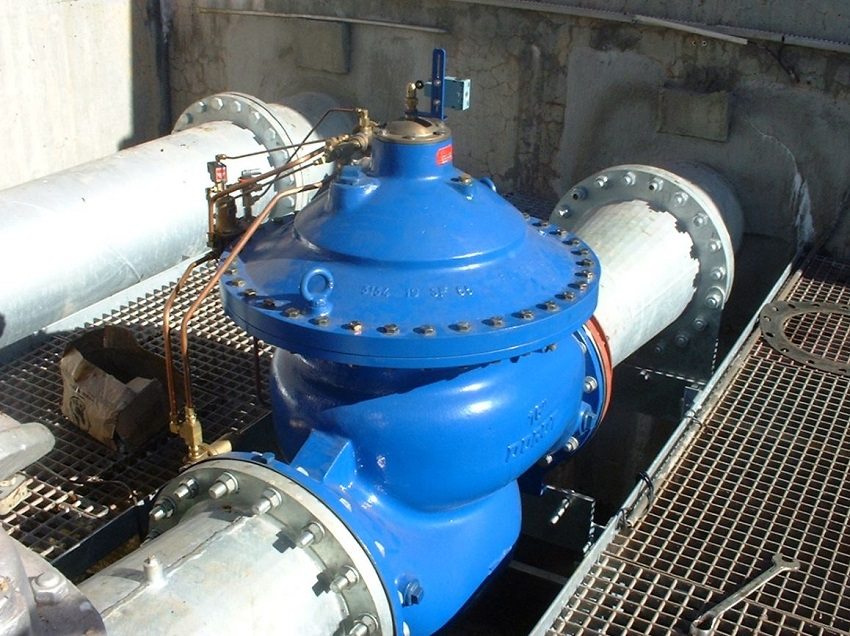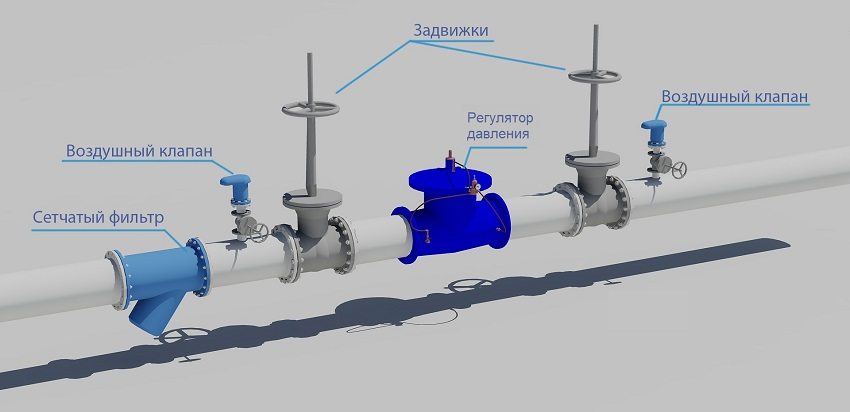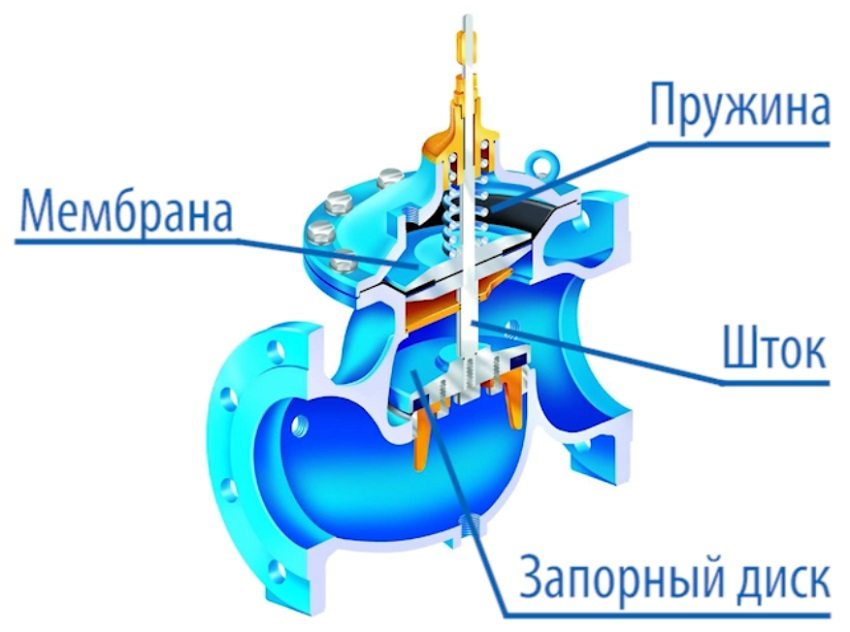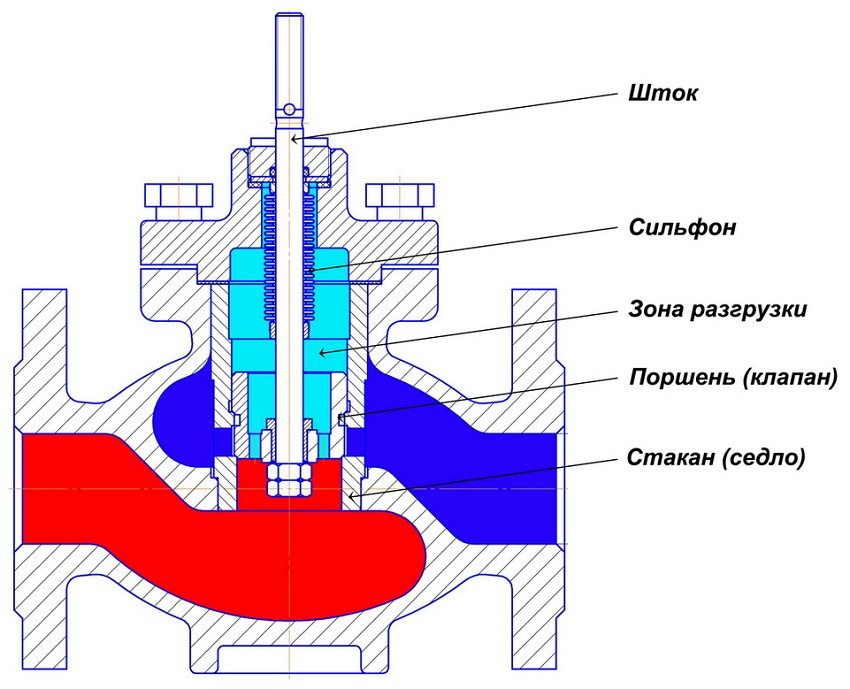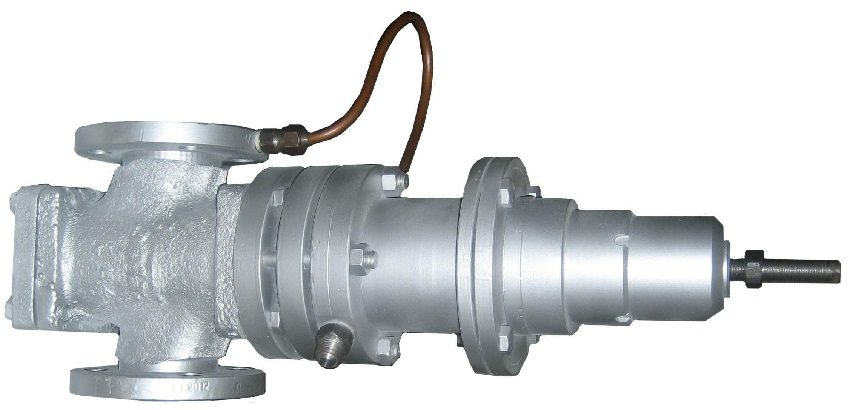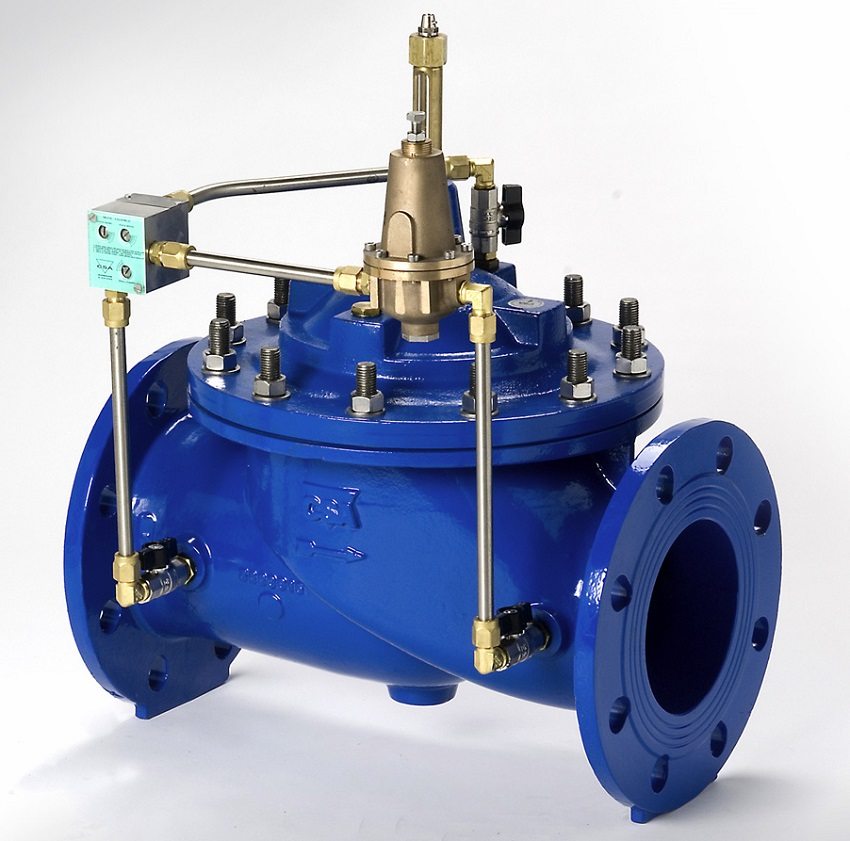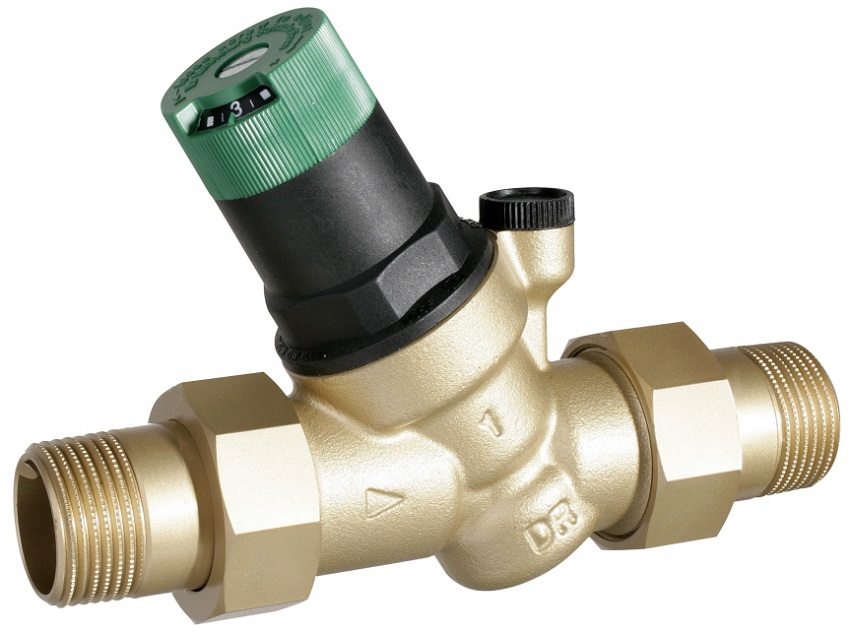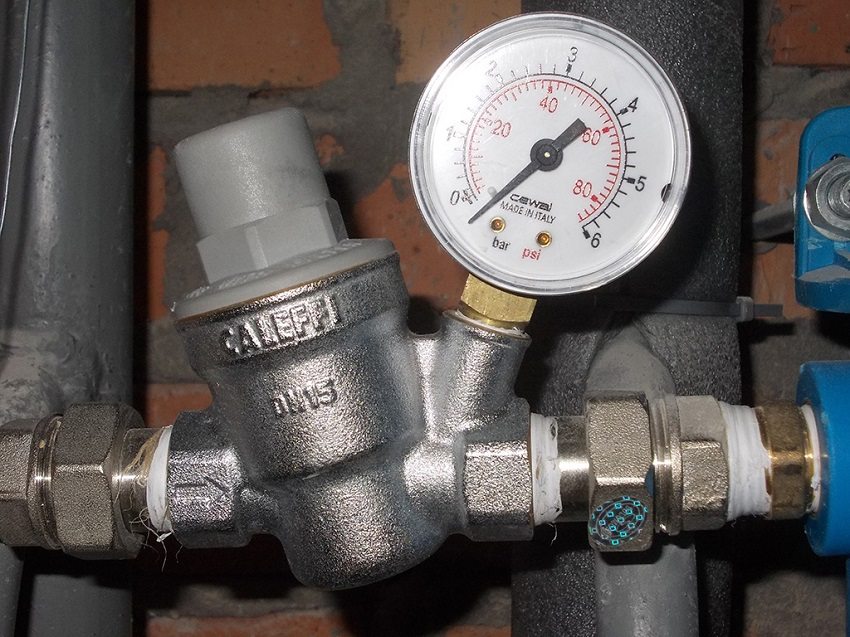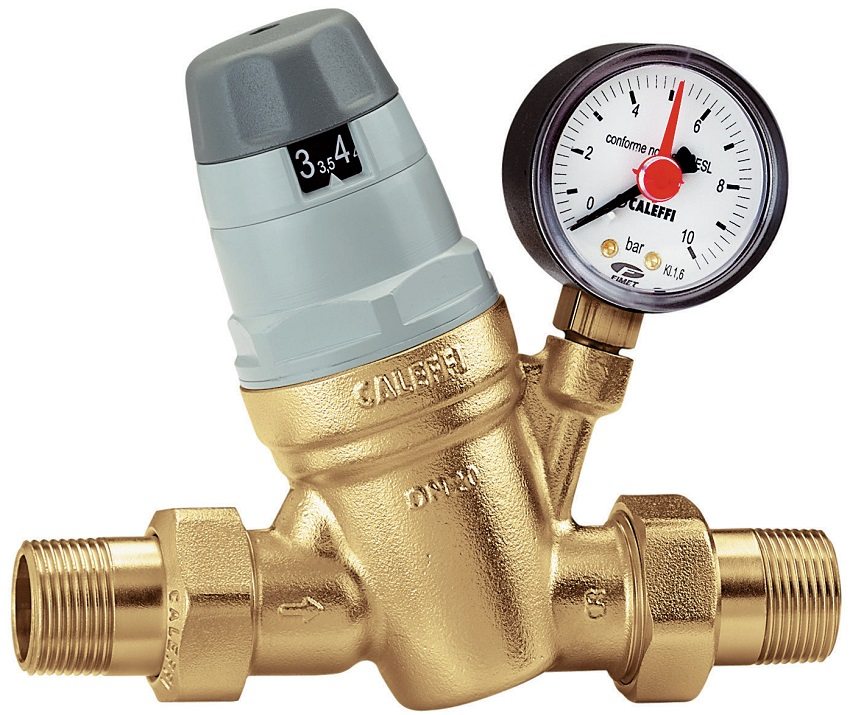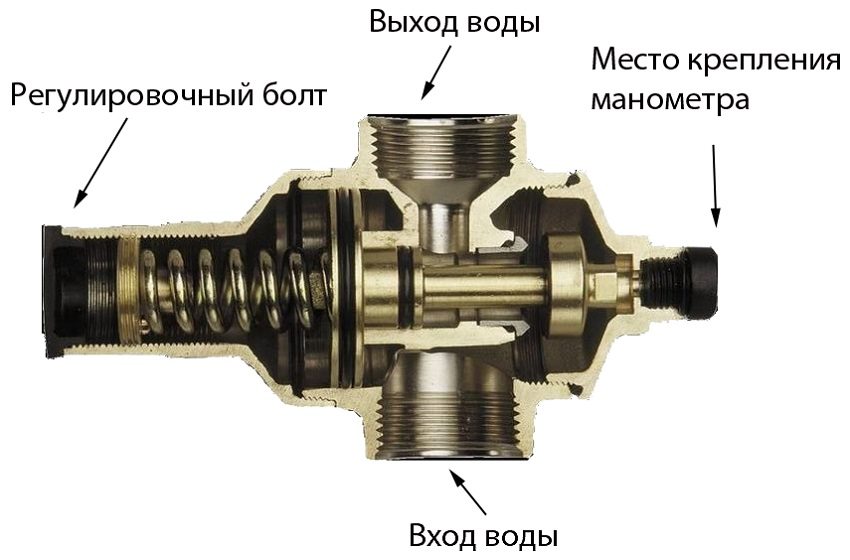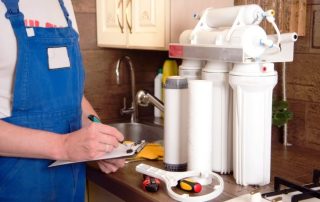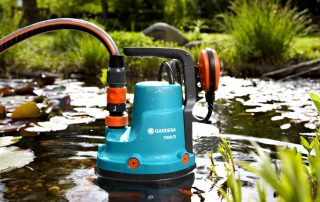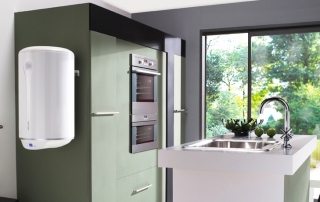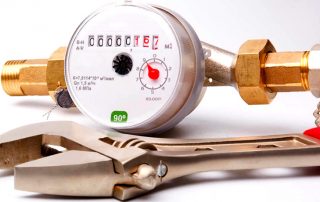The water pressure regulator in the water supply system automatically reduces and maintains a constant pressure in the consumer's network. The operation of the device does not depend on the water flow rate and the initial pressure in the main (distribution) pipeline. The need to install a regulator for household and drinking water (hydrostatic head at the lower point of water withdrawal is more than 45 m) and a separate fire-fighting water supply (head in the lower fire tap is more than 90 m) is noted in the regulatory literature.
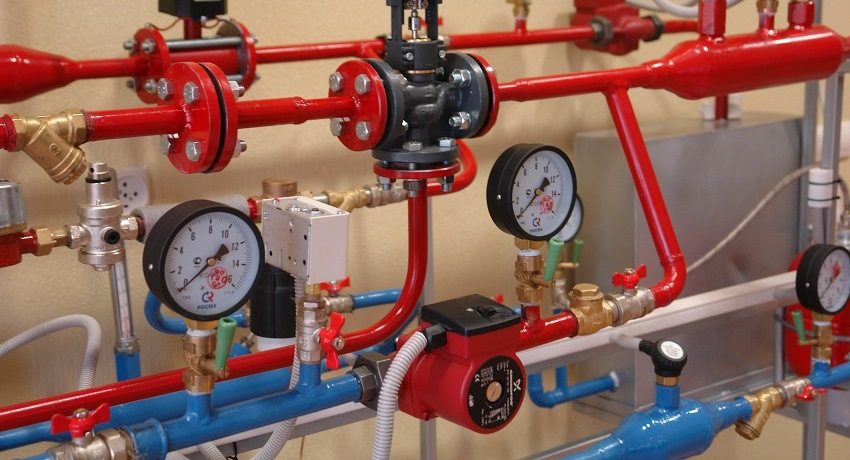
The water pressure regulator in the water supply system automatically reduces and maintains a constant pressure in the consumer's network
Note! The regulator is installed at the entrance to the microdistrict, building, sectional riser of a residential building with a height of more than 40 m or an apartment.
Content [Hide]
- 1 Application of water pressure reducers in water supply systems
- 2 Installation of a water pressure reducer in the water supply system
- 3 Water pressure regulator device
- 4 Water pressure regulators in the apartment
- 5 How the water pressure regulator works
- 6 Water pressure regulator in the apartment: how to regulate the device?
- 7 Water pressure regulator in the water supply system: price of models
Application of water pressure reducers in water supply systems
The device stabilizes pressure and flow in centralized, distribution and autonomous cold water supply networks. Reduction of parameters is necessary for the operation of technological commercial and household hydraulic equipment. Additionally, the reducer dampens hydraulic shocks, eliminates the risk of cavitation zones in pumping equipment, and reduces vibration and noise levels.
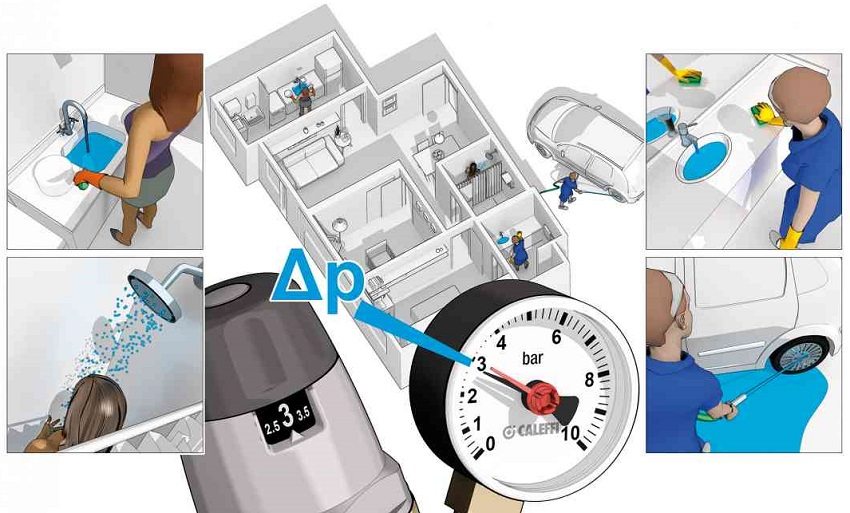
The pressure regulator stabilizes the pressure and water flow in centralized, distribution and autonomous water supply networks
Application of regulators in cold water supply systems:
- municipal and technological water supply networks;
- fire extinguishing systems and fire-fighting water supply;
- booster pumping units on main water supply networks;
- water filling stations;
- irrigation and drainage systems.
Classification of pressure regulators (general specifications):
- working body - piston, valve;
- actuator - spring, membrane;
- control method - electronic, mechanical;
- throughput of fittings - household 0.5 ÷ 3 m³, commercial 3 ÷ 15 m³, industrial over 15 m³;
- body material (cast iron, steel with nickel or chrome plating, brass);
- fastening method - thread (from 15 to 50 mm), flanges (from 50 to 450 mm);
- temperature and type of working environment - cold water with a temperature of 0 ÷ 40 ° C;
- body diameter, thread pitch, flange standard.
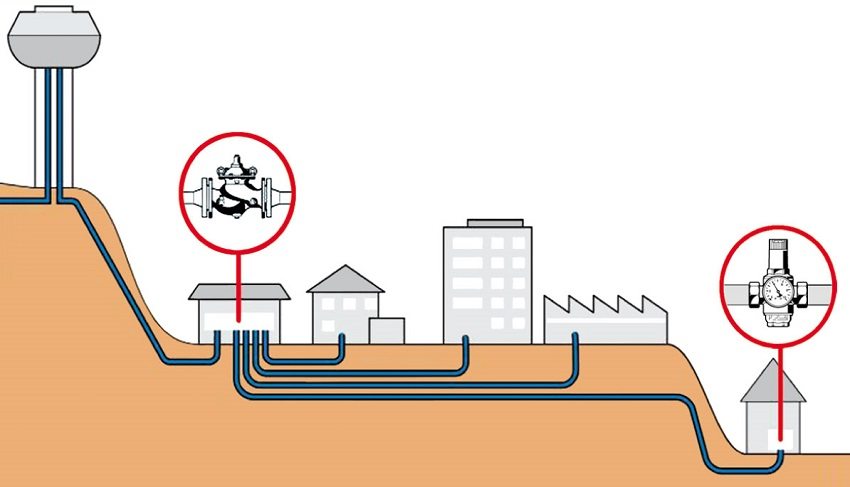
The regulator is installed at the entrance to the microdistrict, building, sectional riser of a residential building with a height of more than 40 m or an apartment
Installation of a water pressure reducer in the water supply system
The device is located at the entrance to the microdistrict (building), behind the stop valves of the water metering unit or boost pumps... Different models of the reducer adjust the pressure in the direction of flow in the line, before or after the installation site of the regulator.
A device in which the degree of valve opening is directly proportional to the pressure deviation relative to the tuning parameters is called a water pressure reducer in the water supply system.
A coarse water filter is installed in front of the large-diameter regulator. After the regulator, a shut-off valve is installed for maintenance, repair or replacement of the device. Adjustment and visual control over the operation of the device is carried out using pressure gauges, which are mounted on the pipeline before and after the regulator.
The method of selecting the device takes into account the throughput (flow rate, m³ / hour) and the permissible head loss (bar) in the housing. Local resistances should not have a critical effect on the operation of the water supply system.
The adjustable setting interval depends on the compression ratio of the spring and the sensitivity of the diaphragm material. The single spring regulator has one pressure setting range. Devices with a set of springs of different stiffness react to the operating conditions of the system more accurately. The optimum position of the operating pressure of the regulator is the middle third of the control range.
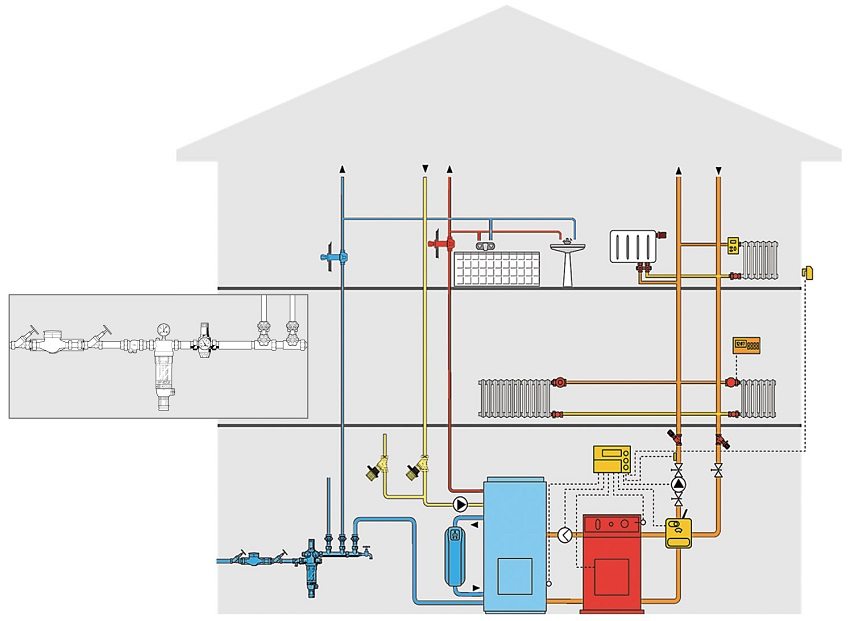
Pressure regulator installation diagram with filter at the water inlet in a private house
The reason for the noise during the operation of the device is cavitation, which occurs due to the excess of the permissible flow rate at the inlet to the regulator. The optimal value for the flow rate is 3 meters per second. Narrowing the flow area between the valve and the seat increases the risk of cavitation in the gear housing.
Important! When choosing a regulator, it is necessary to pay attention to the cavitation coefficient and the recommended speed in the inlet pipe, which are indicated by the manufacturer in the passport of the device.
Water pressure regulator device
Below we consider the devices of the following water pressure regulators:
- lever flange regulator;
- household water pressure regulator RDV;
- direct acting water pressure regulator;
- electronic water pressure regulator;
- water pressure reducer Honeywell.
Lever flange adjusters
A direct-acting hydraulic lever device maintains the set pressure upstream and downstream of the installation site, or regulates the flow rate (differential pressure).
Regulator structural elements:
- body (cast iron, steel);
- cover with stuffing box;
- stem with two valves;
- a lever system with a load and supports to maintain the throughput mode;
- diaphragm actuator.
Models of lever adjusters "before" and "after themselves" are distinguished by the position of the working body in relation to the saddle. The valves that open the passage under the action of the load are designed to regulate the pressure downstream of the installation site. In a reducer that relieves pressure upstream of the installation site, the valve closes the seat passage under the action of a weight. Adjusting the regulator pressure includes calculating the mass and selecting the location of the weight on the lever.
Household water pressure regulator RDV
Industrial, commercial and domestic pressure regulators of the RDV brand are produced by the Russian manufacturer of safety water supply fittings Pascal LLC from Tatarstan.Household water reducers RDV help to reduce pressure, noise and vibration, increase the service life of hydraulic equipment of pipelines and valves. Installation of WFD regulators reduces energy consumption and saves costs for municipal water supply.
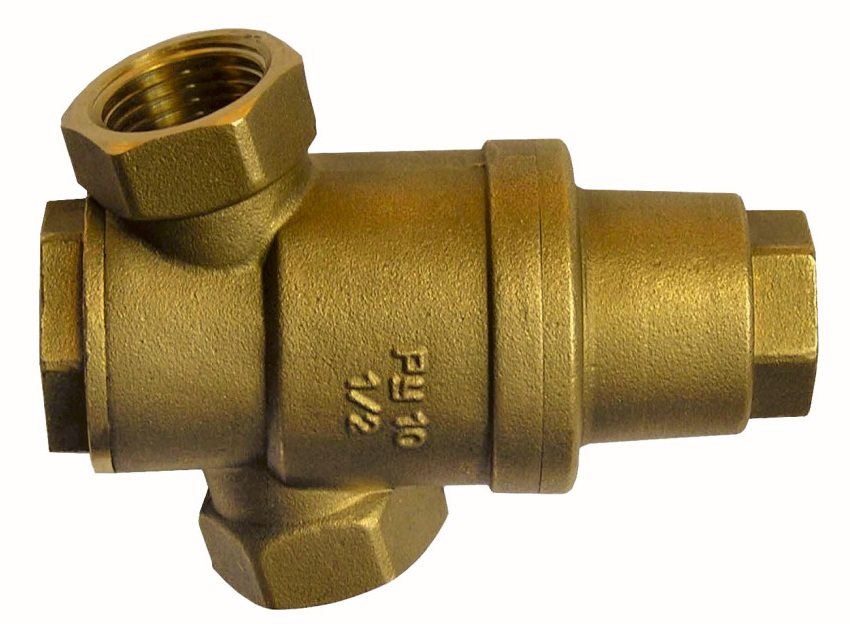
Household water reducers RDV help to reduce pressure, noise and vibration, increase the service life of hydraulic equipment of pipelines and fittings
Direct-acting water pressure regulator RDV
The pilot-type flanged valve features the design of the RDV - an industrial water pressure reducer. The principle of operation is to reduce and maintain a given pressure mode using the energy of the network flow.
Design of the device RDV 150-1G:
- body with flanges (inlet-outlet);
- guide bushings and stem;
- main valve;
- pilot valve body with mechanism and diaphragm (main valve control component);
- membrane;
- impulse tubes.
When the pressure in the pipeline rises above the set value, the impulse flow of water through the tube tends to the pilot valve body. The spring-loaded element opens the channel, the medium enters the chamber above the diaphragm. The curved diaphragm covers the flow area of the regulator. A decrease in pressure in front of the valve returns the spring to its original position, the membrane opens the passage of the device.
Electronic water pressure regulator
An electronic device (press control) turns on a low-power pump if water is taken from the system. Silent operating mode allows you to use the device in an apartment, private house or in the country. The electronic sensor warns the pump operation without water, prevents water hammer, reacts to incorrect pressure and flow rates.
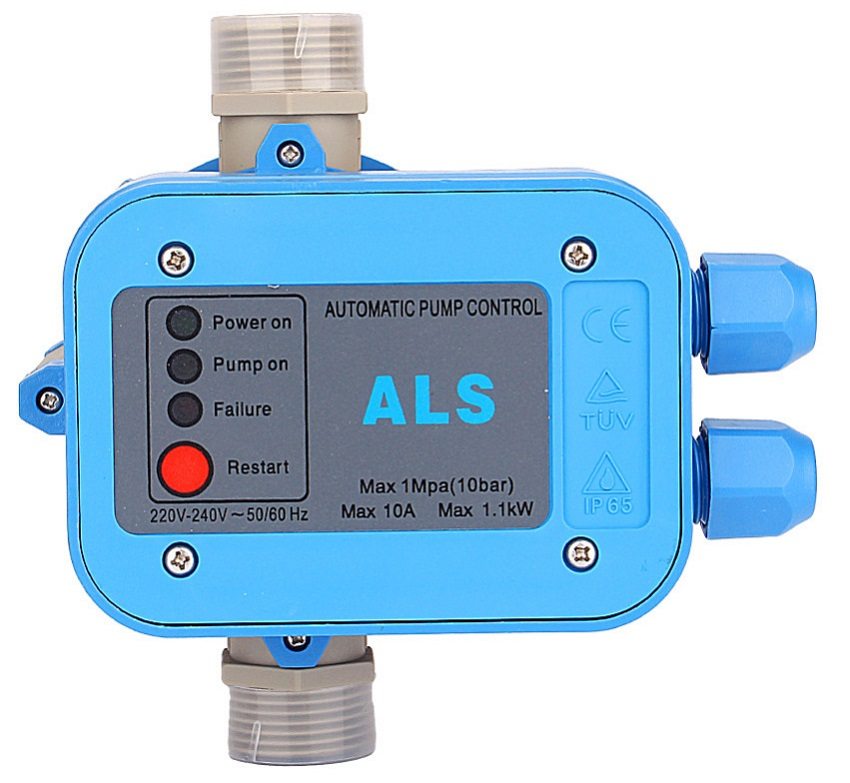
Electronic sensor warns pump operation without water, prevents water hammer, reacts to incorrect pressure and flow rates
The inlet on the body allows the regulator to be installed on the pump body or in the water line. Installation is carried out up to the first water sampling point. The working (installation) position is always vertical. The direction of the arrow on the body follows the direction of the water flow. Check valve built into the electronic regulator. Before turning on the appliance pump fill with water.
Electronic controller design:
- body;
- cap;
- bushings made of technological polymer for cable connection;
- inner diaphragm (EPDM);
- electronic board in a special fireproof casing.
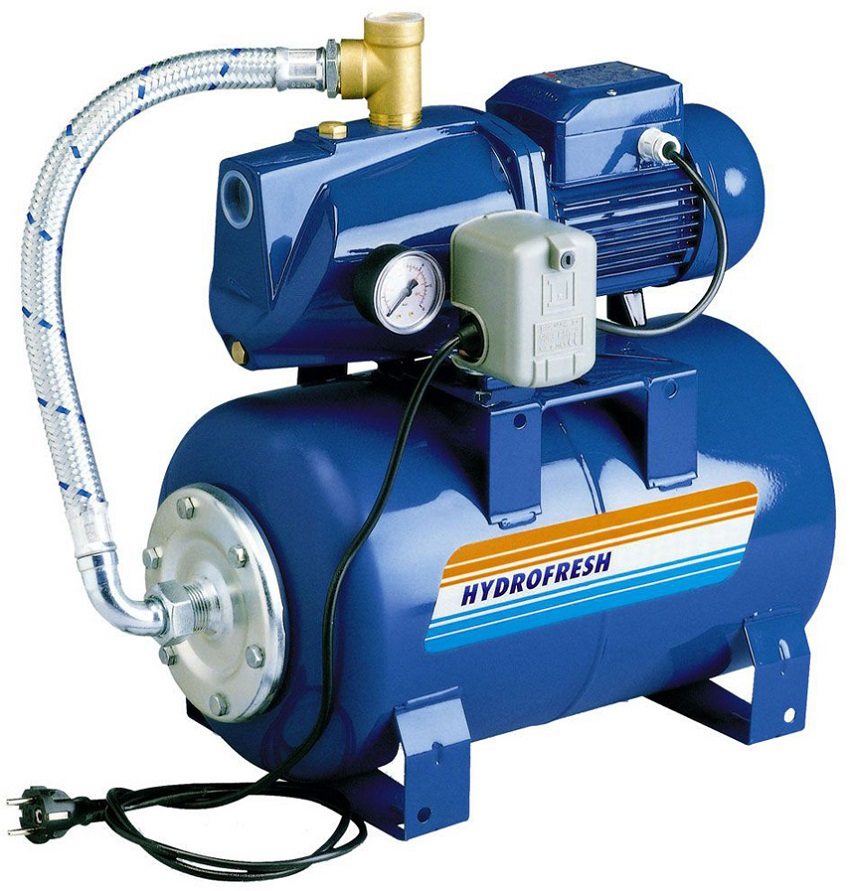
Pumping station complete with electronic water pressure regulator
Electronic water pressure reducer: how to adjust the device?
The starting pressure (1.5 bar) is set by the manufacturer. The nominal pressure of the pump must exceed the starting value of the reducer by 0.8 bar. Changes to the tuning parameters are made as necessary, depending on the operating conditions of the pump. The regulator for setting the starting pressure is turned with a screwdriver.
Important! The nominal pressure of the pump must exceed the starting value of the electronic gear by 0.8 bar. Press control is installed if the water circuit of the system does not exceed 15 meters.
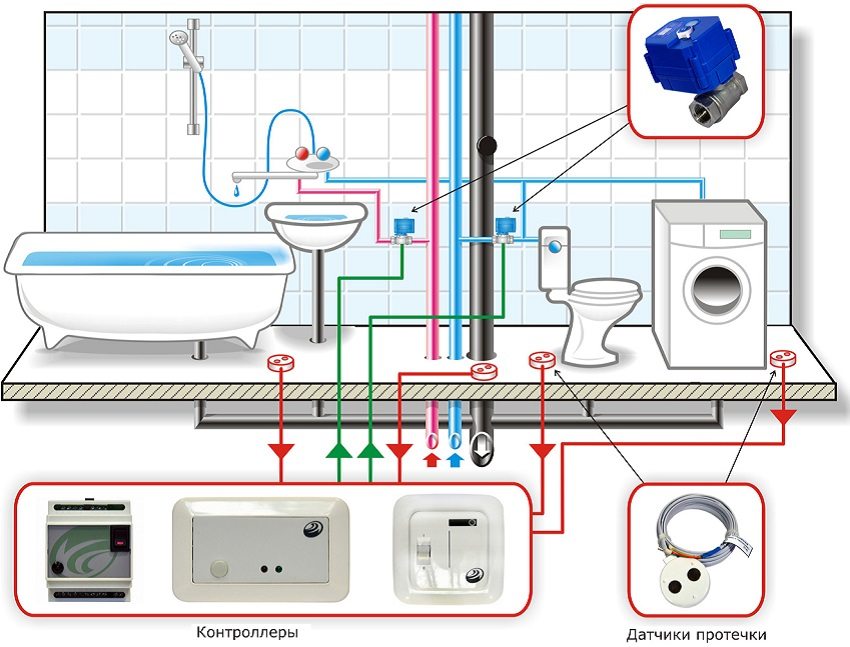
Connection diagram of an electronic water control gearbox to the water supply system of a private house
Honeywell water pressure reducer
Household water pressure regulator Honeywell 1/2 ″ lowers excess pressure in the water supply system, maintains constant parameters of the network, allows you to economically use water. Stable head through the flow area ensures silent operation of the device.
Related article:
|
The Honeywell 1/2 ″ regulator body has a pressure gauge socket.The setting of operating parameters is facilitated by the adjusting knob, on which the positional scale of operating modes is located.
The principle of operation of the device is based on the counteraction of the forces of the diaphragm and the spring, which are affected by the excess pressure of the network.
Water pressure regulator device Honeywell 1/2 ″:
- housing with connecting threads and a pressure gauge socket;
- adjustment knob with a scale;
- working body - adjusting spring;
- actuator - valve and diaphragm.
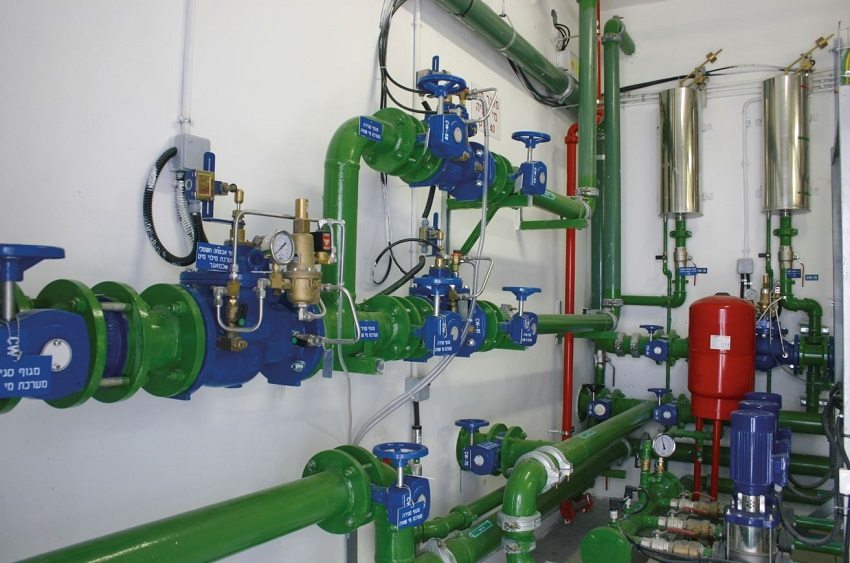
Water pressure regulators prevent the negative effects of significant fluctuations in water pressure at the inlet to the system and water hammer
Honeywell offers a combination filter with flush valve and regulator function in one housing. Pre-purification of cold water from mechanical impurities improves water quality, extends the service life of water pipes and household hydraulic equipment. The mesh filter is washed without turning off the device and stopping the water supply to the water supply of the apartment. The transparent material of the sump body makes it possible to visually determine the degree of filling and the need for cleaning filter.
Water pressure regulators in the apartment
Installing a water pressure regulator in an apartment is an affordable way to improve the quality of water supply. The household regulator maintains the preset water pressure after itself. Sufficient capacity of regulators for an apartment or private house is 3 m³ / hour.
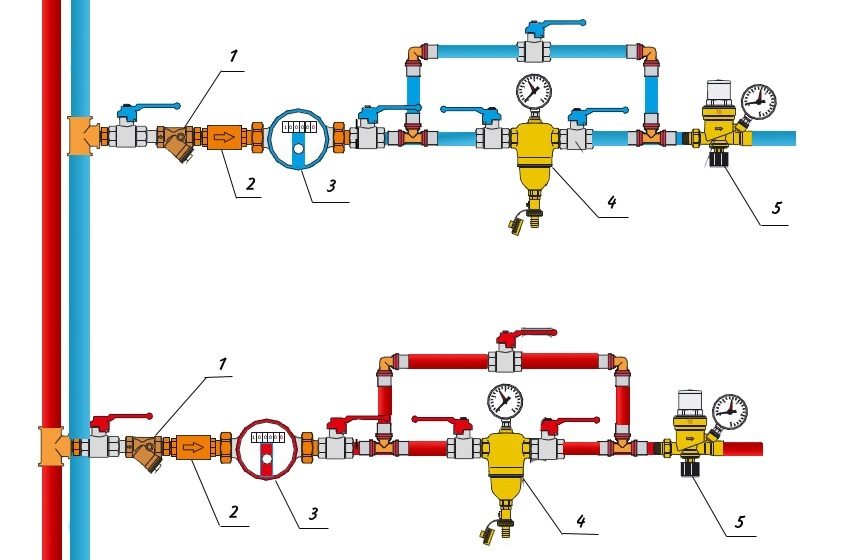
Connection diagram of pressure reducers in the water supply system of the apartment: 1- mechanical coarse filter; 2 - check valve; 3 - hot water and cold water meters; 4 - wash filter; 5 - pressure reducer
Installation rules for household regulators:
- the automatic valve is installed in a heated place accessible for service during operation;
- the body should not experience compression, torsion and bending stresses;
- the direction of the arrow on the body coincides with the course of the flow;
- before installing the regulator, the pipeline is flushed, particles of scale, sand and silt deposits are removed;
- a mesh filter installed after the shut-off valve at the inlet of the water supply to the apartment will improve the operation of the regulator and household hydraulic equipment;
- Shut-off valves (valve) after the regulator are required for maintenance and replacement of the device.
How the water pressure regulator works
A household safety valve regulates the pressure and flow in the water supply. The energy of the flow changes the internal flow area, presses the valve plug into the body seat, closes or opens the water passage, without outside interference. Therefore, a water pressure regulator is called a direct-acting control valve. Exceeding the set pressure leads to partial or complete blocking of the flow area.
The principle of operation of household valves is to counteract and equalize the forces of two elements of the mechanism (executive and working) under the influence of the environment (directed flow). The spring-loaded diaphragm of the pressure sensor reacts to the line pressure on one side, the spring presses against the diaphragm on the other. If the pressure is higher than the allowable one, then the water squeezes out the membrane bridge, which activates the valve (piston).
Water pressure regulator in the apartment: how to regulate the device?
The initial setting of the water pressure regulator takes place at the manufacturer. The preset pressure for household models is 3 bar. It is necessary to independently adjust the values specified by the manufacturer if the pressure of the regulator does not coincide with the operating parameters of the water supply.
In this case, the question arises: how to regulate? The water pressure regulator in the apartment, equipped with a pressure gauge, will not cause any problems.By rotating the adjusting screw, the pressure gauge readings are achieved that correspond to the passport data of the most vulnerable equipment included in the water supply system.
If a cut-in socket for installing a pressure gauge is not provided in the regulator body, then it is installed on the water supply system separately. The accuracy class of the manometer and the measuring range must correspond to the network pressure load. Calibration errors can adversely affect the performance of household hydraulic devices. Adjusting the gearbox blindly, without a clear visual presentation of the result, is impossible.
The adjusting screw with which the adjustment is made is located on the device body. With a wrench or hex wrench, turn the screw in the direction of increasing or decreasing the setting parameter. Rotation of the screw head presses or weakens the spring, which presses on the working element (valve or piston). They produce models of devices that are equipped with a special adjustment knob on the stem and fittings for manometers.
Procedure:
- open the valve on the inset of the water supply to the apartment;
- close water sampling points (mixer, flush cistern, water heater, washing machine and dishwasher, drinking water filter);
- set the required pressure on the pressure gauge (2 ÷ 3 bar);
- open the taps at the points for water intake, check that the pressure corresponds to the specified parameter.
Important! If the pressure change is in the range of ± 10%, then the set value corresponds to the effective operation of the regulator.
Water pressure regulator in the water supply system: price of models
You can choose and buy a water pressure regulator based on the following table of manufacturers, characteristics and prices:
| Name / Country of origin | Dy, mm | Output pressure adjustment range P, atm | Price, rub |
| Pressure regulator DRV / NWatts (Denmark) | 15 | 1,5÷6,0 | 3400.00 |
| Icma regulator (Italy) | 15 | 1÷6, 5 | 608.00 |
| Industrial regulator RDV 150 - 1G (Russia) | 150 | 2÷16 | 108150.00 |
| Regulator for household and commercial use RDV15-2A-M (Russia) | 15 | 1,2÷2,1 | 667.28 (wholesale price) |
| Regulator for household and commercial use RDV20-2A-M (Russia) | 20 | 1÷16 | 1227.51 (wholesale price) |
| Regulator for household and commercial use RDV25-2A-M (Russia) | 25 | 1÷16 | 1741.22 (wholesale price) |
| Reducer of pressure of water Honeywell, with thread 1/2 "(Germany) | 15 | 1,5÷6,0 | 1860.00 |
| Filter Honeywell FK06-3 / 4 ″ -AA for cold water, with a flushing valve and pressure reducer. | 20 | 0÷16 | 6440.00 |
| Reducer Honeywell D06F-1/2 ″ A, water pressure reducing valve | 15 | 1,5÷6,0 | 4102.00 |
| Electronic water pressure regulator (with an air-collecting tank) Pedrollo EASYPRESS (Italy) | 25 | 1,5÷10 | 11424.00 |
| Electronic pressure regulator EDD-5 (China) | 25 | 1÷10 | 1750.00 |
| Electronic pressure regulator EDD-1 (China) | 25 | 2080.00 | |
| Lever flange regulator, "upstream" RD2103 | 50 | 0,15÷13 | 8900.00 |
| Direct Acting Pressure Regulator, Downstream 24646, Spring Loaded | 25 | 0÷16 | 4944.00 |
| Pressure reducer VT.082.N.04 with pressure gauge and strainer | 15 | 2÷5 | 1043.00 |
Prices for domestic pressure regulators for cold water supply differ from the cost of imported devices. Competition between manufacturers is reflected in the range and properties of the offered product. Domestic analogues of foreign safety valves are inferior in terms of design and operating comfort, not to the detriment of the quality of the regulators.
